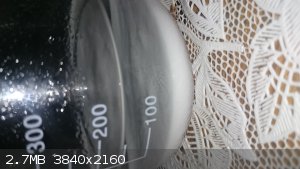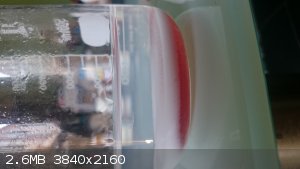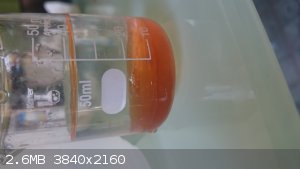bolbol
Hazard to Others
  
Posts: 167
Registered: 3-1-2015
Member Is Offline
Mood: No Mood
|
|
Fun/cool reactions/experiments to do with CS2?
I got my hands on ~800 mls of CS2.
I needed around 200 mls for realgar(As4S4) mineral recrystallization so I'll have plenty left over.
The things I've noticed so far are that it retracts light and it burns with a very nice blue flame.
I know about the barking dog reaction but I'm not sure if it's something I'd wanna do.
Anything you guys can think of? I heard it dissolves some semi metallic elements. I tried arsenic and it didn't seem to dissolve any. Would it
dissolve red phosphorus? It would be interesting to see what color flame that solution would burn at.
|
|
|
NitreRat
Harmless

Posts: 45
Registered: 22-1-2015
Location: Cyberspace
Member Is Offline
Mood: No Mood
|
|
You could make some Carbon tetrachloride and use it to write your name into the ozone layer
|
|
|
DraconicAcid
International Hazard
    
Posts: 4416
Registered: 1-2-2013
Location: The tiniest college campus ever....
Member Is Offline
Mood: Semi-victorious.
|
|
You can react with with ionic sulphides to make orange trithiocarbonates. Or calcium hydroxide to give calcium trithiocarbonate via
3 Ca(OH)2 + 3 CS2 --> CaCO3(s) + 2 CaCS3(aq) + 3 H2O.
Please remember: "Filtrate" is not a verb.
Write up your lab reports the way your instructor wants them, not the way your ex-instructor wants them.
|
|
|
bolbol
Hazard to Others
  
Posts: 167
Registered: 3-1-2015
Member Is Offline
Mood: No Mood
|
|
Quote: Originally posted by DraconicAcid  | You can react with with ionic sulphides to make orange trithiocarbonates. Or calcium hydroxide to give calcium trithiocarbonate via
3 Ca(OH)2 + 3 CS2 --> CaCO3(s) + 2 CaCS3(aq) + 3 H2O. |
By ionic sulphides you mean sulfide salts that dissolve in water? How much water/CS2 ratio is required?
|
|
|
DraconicAcid
International Hazard
    
Posts: 4416
Registered: 1-2-2013
Location: The tiniest college campus ever....
Member Is Offline
Mood: Semi-victorious.
|
|
Yes, soluble ionic sulphides. I don't know about the ratio of water to CS2. You want enough water to dissolve the ionic sulphide, then add CS2
slowly until it's done reacting.
Please remember: "Filtrate" is not a verb.
Write up your lab reports the way your instructor wants them, not the way your ex-instructor wants them.
|
|
|
solitanze
Harmless

Posts: 26
Registered: 4-2-2016
Member Is Offline
Mood: No Mood
|
|
You could prepare xanthate salts from CS2 and KOH (or NaOH) in ethanol: EtOH + CS2 + KOH → EtOCS2K + H2O
From there you could prepare various xanthate esters, via alkyl halide.
Alkaline CS2 dissolves cellulose, which is interesting.
|
|
|
bolbol
Hazard to Others
  
Posts: 167
Registered: 3-1-2015
Member Is Offline
Mood: No Mood
|
|
Quote: Originally posted by solitanze  | You could prepare xanthate salts from CS2 and KOH (or NaOH) in ethanol: EtOH + CS2 + KOH → EtOCS2K + H2O
From there you could prepare various xanthate esters, via alkyl halide.
Alkaline CS2 dissolves cellulose, which is interesting. |
Would methanol work too? I happen to have some
|
|
|
DraconicAcid
International Hazard
    
Posts: 4416
Registered: 1-2-2013
Location: The tiniest college campus ever....
Member Is Offline
Mood: Semi-victorious.
|
|
I'm not sure if you can react an alcohol directly with CS2 to get the xanthate; Cotton & Wilkinson say they can be formed by reacting the alkoxide
with CS2. Primary and secondary amines will react with CS2 in the presence of base to give dithiocarbamates, though. Tertiary phosphines will
similarly react with CS2 to give a zwitterionic beast which makes a cool ligand.
Please remember: "Filtrate" is not a verb.
Write up your lab reports the way your instructor wants them, not the way your ex-instructor wants them.
|
|
|
bolbol
Hazard to Others
  
Posts: 167
Registered: 3-1-2015
Member Is Offline
Mood: No Mood
|
|
I tried it with methanol. I made a room temp sat solution of NaOH in methanol and added CS2 to it until it stopped reacting. Decanted the top piss
yellow colored layer and added HCl to it. And here's what I got
I added cotton to a small sample of the solution before adding the HCl and It didn't seem to dissolve any
[Edited on 12-5-2016 by bolbol]

|
|
|
Metacelsus
International Hazard
    
Posts: 2544
Registered: 26-12-2012
Location: Boston, MA
Member Is Offline
Mood: Double, double, toil and trouble
|
|
Yes, you can. I've done it with KOH and isopropanol. The product precipitates as a yellow solid. Yields might be better using the pre-formed alkoxide,
but the direct reaction is definitely feasible.
Also: Imgur is notorious for losing images after a few years. If you don't want that to happen, just attach the image directly to your post on
Sciencemadness.
[Edited on 5-12-2016 by Metacelsus]
|
|
|
bolbol
Hazard to Others
  
Posts: 167
Registered: 3-1-2015
Member Is Offline
Mood: No Mood
|
|
I was about to filter off this stuff in the morning and I noticed this nice red colored layer...
I noticed a few blobs yesterday night but I'm pretty sure it formed overnight.
Any ideas about what it is?

[Edited on 12-5-2016 by bolbol]

|
|
|
woelen
Super Administrator
        
Posts: 8083
Registered: 20-8-2005
Location: Netherlands
Member Is Offline
Mood: interested
|
|
CS2 does not dissolve red P. Actually, there is no solvent which dissolves red P without converting it to something else (e.g. oxidizing it to
phosphate or phosphite). White P dissolves very well in CS2. When such a solution is poured over paper and the CS2 is allowed to evaporate, then after
a minute or so the white P bursts in flame. At that time, the CS2 already is gone and does not contribute to the reaction. It is the white P which
gives the spectacular reaction.
Be VERY careful with this solution of white P in CS2. If you get this on the skin you have a serious problem. The CS2 quickly evaporates and what
remains on your skin is a thin layer of white phosphorus, which is extremely poisonous and may lead to fire on your skin, leading to exceptionally
dangerous wounds (combination of burn and white P poisoning). If you ever get any solution of white P on your skin, then IMMEDIATELY rinse with a lot
of clean CS2 in a well ventilated place or immerse in a cold solution of CuSO4, otherwise you're screwed.
CS2 does dissolve iodine and sulphur very well. You can make concentrated solutions of these elements and these solutions are very reactive. One
interesting thing is to add some powdered tin to CS2 and then add iodine. The tin is converted to beautiful red SnI4.
Just for fun, put a single small drop of a solution of sulphur in CS2 on your thumb. The CS2 evaporates in seconds. After that, you really can smell
the sulphur. This demonstrates that sulphur has quite a strong and peculiar, but for many people familiar smell.
A nice experiment is to add some sulphur to a solution of NaOH and then heat the solution, until all sulphur has dissolved. This solution contains
sulfide ion and thiosulfate ion. Add a few drops of CS2 to this solution to get the thiocarbonate ion CS3(2-) in solution.
The barking dog reaction can be done safely. A safer version on a smaller scale is presented here, together with the original large scale version:
http://woelen.homescience.net/science/chem/exps/barkingdog/i...
CS2 itself also is quite toxic, but it is not instant death in a bottle. To my opinion the risk of poisoning is exaggerated. As with many other
solvents, try to avoid inhaling much of the vapor but if a whiff of it is inhaled accidently there is no need to worry if this occurs occasionally. If
you get some CS2 on your skin just let it evaporate quickly. I have had this happen quite a few times without any nefarious after-effect. Only if you
work with CS2 professinally and you get exposed every day, then there is a serious long-term risk.
One thing which really must be taken into account is the low temperature of ignition of CS2. Water at 100 C can ignite CS2 (it is borderline on
ignition temperature). A hotplate at 150 C or so certainly does ignite vapor of CS2. So be careful with hot objects around if you use CS2.
Another experiment which is supposed to be cool is mixing CS2 and CCl4 and pouring some of this mix on your skin and igniting the vapor of this mix.
The mix burns with a blue flame, but this flame apparently is so cold that you can have it on your hand without gettting burnt. I never tried this
personally. CCl4 is far more toxic than CS2 and it is a well-known carcinogen. I would not pour this deliberately on my skin.
[Edited on 12-5-16 by woelen]
|
|
|
Metacelsus
International Hazard
    
Posts: 2544
Registered: 26-12-2012
Location: Boston, MA
Member Is Offline
Mood: Double, double, toil and trouble
|
|
Quote: Originally posted by bolbol  | I was about to filter off this stuff in the morning and I noticed this nice red colored layer...
I noticed a few blobs yesterday night but I'm pretty sure it formed overnight.
Any ideas about what it is?
|
I also noticed that red layer sometimes when I was doing the reaction with isopropanol. However, it didn't always appear. All my attempts to isolate
the compound causing the red color failed (I tried extraction with organic solvent, and also crystallization). My guess is that it was some sort of
polysulfide, potentially formed from impurities in the carbon disulfide.
|
|
|
bolbol
Hazard to Others
  
Posts: 167
Registered: 3-1-2015
Member Is Offline
Mood: No Mood
|
|
I separated it and added water on the top because it smelled harsh. After a while the redness went away and it turned dark yellow.
|
|
|